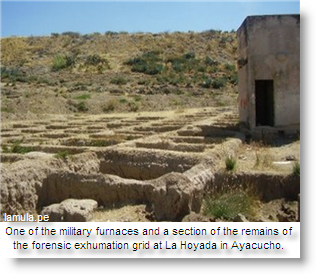 The regional government of Ayacucho has declared an area known as La Hoyada as a conservation zone, in memory of more than 100 people who were tortured and killed there during the internal conflict between the Peruvian state and leftist Shining Path rebels.
The regional government of Ayacucho has declared an area known as La Hoyada as a conservation zone, in memory of more than 100 people who were tortured and killed there during the internal conflict between the Peruvian state and leftist Shining Path rebels.
The measure is the first step in preserving the area in order to set up a place to remember the victims of the conflict, according to the news site Noticia Ser.
The Ayacucho regional government also aims with this decision to prevent groups seeking to illegally take over the land, following the Judiciary’s decision to revoke an ordinance that declared it an intangible area.
“We hope that soon they will declare La Hoyada a Memory Sanctuary and create a project that can be implemented,” said Felimon Salvatierra, the president of a group called the Regional Coordinator for those Affected by Political Violence in Ayacucho.
Ayacucho was the center of Peru’s Shining Path insurgency, which launched its first actions in 1980. Some 70,000 people were killed in the conflict. Most of the victims were rural, indigenous Quechua speakers caught in the middle of the Shining Path attacks and the Peruvian military’s counter-insurgency campaign.
Between early 2005 and 2007, a team of 20 forensic anthropologists exhumed more than 100 bodies at La Hoyada, including those of several children. The victims were tortured and killed inside the Los Cabitos military barracks compound between 1983 and 1985. La Hoyada, a 4,000 square meter wasteland adjacent to the principal barracks, was used for disposal of the bodies.
The forensic team also found broken and charred remains of many other victims, heaps of human ashes in a garbage dump, as well as the remains of blast furnaces and industrial-like installations with three-phase wiring.
The Truth and Reconciliation Commission reported testimonies of 138 cases of people tortured or murdered at Los Cabitos between 1983 and 1984, but later a former intelligence officer, Jesús Sosa, told investigative journalist and author Ricardo Uceda that he himself had disinterred 300 bodies at La Hoyada to then incinerate them in the furnaces.
In 2008, after three years of forensic work, the head of the Legal Medicine Institute, Luis Bromley, said “More than 1000 people came through the barracks as arrested persons and never left.” He added that “it’s chilling what we have been discovering in each grave — men, women and children murdered. A child and an unborn child are not terrorists, there is no justification for these deaths.”





